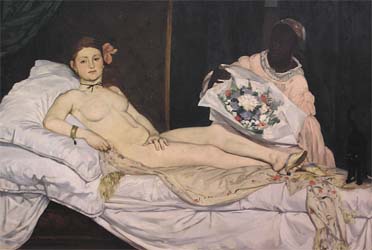
Manet's painting of Olympia which he painted in 1863 was exhibited in the Salon of 1865:

In creating this image, he was placing it within the whole discourse of the nude in Western Art especially contemporary French painting. Compare it to the images collected on the page entitled Nineteenth Century Images of the Nude. Identify significant parallels to other nineteenth century images. It is well known that Manet based his painting on Titian's Venus of Urbino which Manet had copied in Florence in 1853:

Compare these two works closely. Pay attention to the significant changes Manet has introduced in his figure.
When Manet exhibited Olympia at the Salon of 1865, it was greeted with intense ridicule. The popular press published satires like the following:
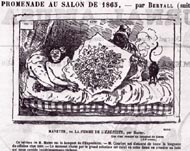
The following are excerpts from the popular press responding to the exhibition of Olympia:
This excerpt is from a Salon review which appeared in the paper La France:
Each day [Olympia] is surrounded by a crowd of visitors, and in this constantly changing group, reflections and observations are made out loud which spare the picture no part of the truth. Some people are delighted, they think it a joke that they want to look as if they understood; others observe the thing seriously and show their neighbour, here a well-placed tone, and there a hand which is improper, but richly painted; finally one sees painters whose work was rejected by the salon jury this year --and there is the proof that they do exist-- standing in front of the picture, beside themselves with spite and indignation. Very probably everyone is right to some extent, and such diverse opinions are authorized by the incredible irregularities of Monsieur Manet's work. He has shown mere sketches. Yet we are not of the opinion, which is too widespread, that his negligence is a parti pris on his part, a sort of ironic defiance hurled at the jury and the public. The jury would certainly have distinguished a studio jape from an unsatisfactory work of art, and would have closed the doors of the Palais des Champs-Elysées against it. From another point of view, an artist cannot treat the public lightly without compromising his reputation, which sometimes never recovers; and Monsieur Manet, who appears at each exhibition, is certainly pursuing something other than the sad celebrity obtained by such perilous procedures. We prefer to think he has made a mistake. And what is his aim? His canvases are too unfinished for us to possibly tell.
The following is from the journal La Fraternité Littéraire:
What verse! What a picture! Olympia awakes, weary from ... dreaming.
She has had a bad night, that is evident. Insomnia and colic have
disturbed her serenity; her color indicates as much. There are
two "black messengers": a cat which has been unfortunately
flattened between two railway sleepers; a negress who has nothing
about her that "recalls the amourous night" unless it
be a bouquet bought at the florist's on the corner, and paid for
by Monsieur Arthur, which tells me a great deal about Olympia.
Arthur is certainly in the antechamber waiting.
Modern discussions of Olympia regularly compare it to paintings like Alexandre Cabanel's The Birth of Venus:
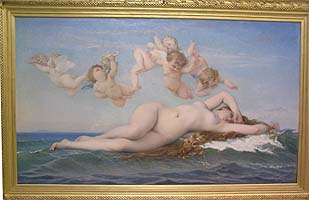
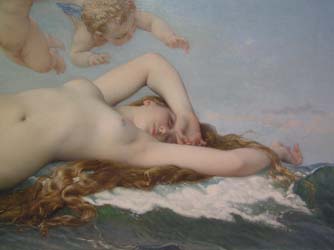
When it was exhibited at the Salon of 1863, the Cabanel was considered one of the major works of the exhibition. It was acquired by Napoleon III. Today, while the Manet painting is considered to be one of the major monuments of western painting, the Cabanel painting has faded into obscurity until recent years when art historians have begun to reconsider academic painting.
A lesson to be learned is that what can be scandalous for one generation can be considered to be canonical in another. It is instructive to compare the public outcry over the exhibition of Olympia to the response to the Brooklyn Museum show during the Fall of 1999 entitled Sensation. Why would Manet's painting be so scandalous?
Excerpt from T.J. Clark's "Olympia's Choice," The Painting of Modern Life: Paris in the Art of Manet and his Followers:
p.131: A nude...is a picture for men to look at, in which Woman is constructed as an object of somebody else's desire. Nothing I go on to say about Olympia is meant to suggest that Manet's painting escapes that wider determination, or even escaped it once upon a time, in the 1865 Salon. It was meant as a nude and finally taken as one; the texts I have collected should not be read as so many indices of defeat in that project, but, rather, for signs of difficulty surmounted. The critics were obliged to take a metaphorical detour, produce their own hesitations, play with the picture's recalcitrance, before they declared it a nude of some kind --comic perhaps, or obscene, or incompletely painted. Nonetheless, the difficulties counted in 1865: the anger and the uncertainty were not simply ersatz. The anger needs explaining, therefore; even if, in the critics' writing, it is already presented in retrospect, as a kind of fiction.
I have argued the gist of the matter already. Olympia is depicted as nude and courtisane, but also as naked and insoumise; the one identity is the form of the other, but the two are put together in such a way as to make each contingent and unfinished. The case is particularly clear when it comes to the picture's obvious main subject: Olympia's beauty, her sexual power, and how that relates to her body's being female. It is sometimes /p. 132: said --it was already in 1865-- that Olympia is not female at all, or only partly so. She is masculine or "masculinized"; she is "boyish," agressive, or androgynous. None of these words strikes me as the right one, but they all indicate quite well why the viewer is uncertain. It is because he cannot easily make Olympia a Woman that he wants to make her a man; she has to be something less or more or otherwise aberrant. This seems to me wrongheaded: surely Olympia's sexual identity is not in doubt; it is how it belongs to her that is the problem.
The achievement of Olympia, I should say, is that it gives its female subject a particular sexuality as opposed to a general one. And that particularity derives, I think, not from there being an order to the body on the bed but from there being too many, and none of them established as the dominant one. The signs of sex are present in plenty, but they fail, as it were, to add up. Sex is not something evident and all of a piece in Olympia; that a woman has a sex at all --and certainly Olympia has one-- does not make her immediately one thing, for a man to appropriate visually; her sex is a construction of some kind, or perhaps the inconsistency of several.
To show this in detail, I shall first of all point to the way the body is addressed to the viewer in Olympia, and then go on to talk of the body's "incorrectness," as a thing drawn and painted; from there I shall move to the particular marks of sex upon it, and how they are handled; and, finally, to the way the body is inscribed in paint.
A nude could hardly be said to do its work as a painting at all if it did not find a way to address the spectator and give him access to the body on display. He had to be offered a place outside the picture, and a way in; and be assured somehow that his way was the right one, leading the knowledge he required. This was sometimes done simply by looking: by having the woman's eyes and face, and her whole body, address themselves to the viewer, in the fashion of Ingres's Vénus Anadyomène or Titian's /p. 133: Venus of Urbino. That candour, that dreamy offering of self, that looking which was not quite looking: those were the nude's most characteristic forms of address. But the outward gaze was not essential; the spectator could be offered instead a pair of eyes within the picture space-- the look of Cupid or the jester's desperate stare, the familiarity of a servant or a lover. In any case, the woman's body had to be arranged in precise and definite relation to the viewer's eye. It had to be placed at a distance, near enough for seeing, far enough for propriety. It had to be put at a determinate height, neither so high that the woman became inaccessible and merely grand, nor so low that she turned into matter for scrutiny of a clinical or prurient kind.
There were fragile achievements, and open to burlesque or refutation. But that was not what took place in Olympia, for all the critics' occasional certainty that her look was a provocation and her body laid out for inspection at the morgue. By and large the critics could not dismiss the picture in this way, because they could not so easily specify their own exclusion from it.
They were offered an outward gaze: a pair of jet-black pupils, a slight asymmetry of the lids, a mouth with a curiously smudged and broken corner, features half adhering to the plain oval of the face. A look was thus constructed which seemed direct and reserved, in a way which was close to the classic face of the nude. It was close , but so is parody. This is not a look which is generalized or abstract or evidently "feminine." It appears to be blatant and particular, but it is also unreadable, perhaps deliberately so. It is candid but guarded, poised between address and resistance --so precisely, so deliberately, that it comes to be read as a production of the depicted person herself; there is an inevitable conflation of the qualities of precision and contrivance in the way the image is painted and those qualities as belonging to the fictive subject; it is her look, her action upon us, her composition of herself.
It is not just looking: it is not the simple, embodied gaze of the nude. Aggression is not the word for it; that quality is displaced to the cat and given comic form. Compliance is inaccurate; that is the Negress's character, and what makes her inert and formulaic, a mere painted sign for Woman in one of her states. Olympia, on the other hand, looks out at the viewer in a way which obliges him to imagine a whole fabric of sociality in which this look might make sense and included him-- the fabric of offers, places, payments, particular powers, and status which is still open to negotiation. If all of that could be held in the mind, the viewer might have access to Olympia; but clearly it would no longer be access to a nude.
/p. 134: Yet in a rough-and-ready way the viewer puts an end to this stalement, at least temporarily, and tries to see Olympia's body as one thing. We have noticed already the signs of the critics' disappointment even her. The body was not one thing; it was pulled out of shape, its knees dislocated and arms broken; it was cadaverous and decomposing; falling apart or held together by an abstract, rigid armature of lead or plaster or India rubber; it was simply incorrect. These are the signs of panic and incomprehension in the critics, but they have some basis in the way Olympia's body is actually drawn. One aspect of that drawing is emphatically linear: it is the side seized on by some writers in 1865 and described in such phrases as "circled in black," "drawn in charcoal," and "stripes of blacking." These were ways of objecting to Manet's disregard of good modelling and the abruptness of his lights and darks. But this use of shadow --these lines of darkness put round heel or breast or hand--is also part of Manet's drawing, in the limited sense I want that word to have here. Olympia's whole body is matter of smooth hard edges and deliberate intersections; the lines of her shoulders are a good example, singular and sharp; or the way the far nipple breaks the bounding line of the arm with a neatness nothing short of ostenation; or the flat, decorative edge of the thigh and the kneecap , or the hand staked out on its grey surroundings. This kind of drawing is presumably what was meant by the journalist Gille when he talked o Olympia's being full of "jarring lines which made one's eyes ache." But it was just as common in 1865, and just as appropriate, for the critics to accuse the picture of lacking definition. It was "unfinished," adter all, and drawing "does not exist" in it' it was described as "impossible" or evasive or "informe...."
One aspect of this is again the picture's suppression of halftones: it lies behind the lack of detail in Olympia's right breast, and the faded bead of her nipple; it is what makes the transition from breast to rib cage to stomach to thigh so indistinct, so hard to follow. But the body contains quite another kind of ambiguity, harder and sharper and more directly tied to line: the direction of Olympia's forearm, for example, as it crosses her belly --perhaps touching it, perhaps not--is as much a matter if high visual uncertainty.
I couldn't resist the following:
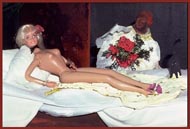
This was taken from a site giving a Barbie's view of the History of Art.